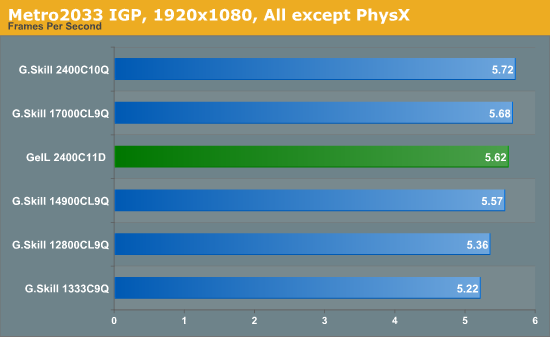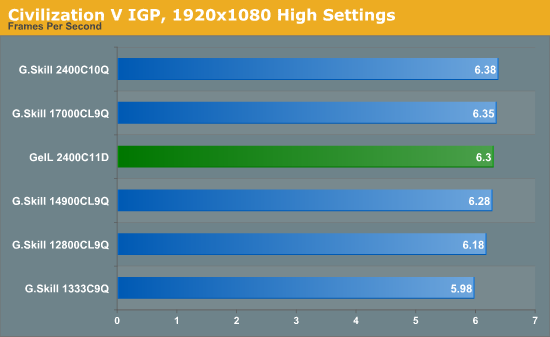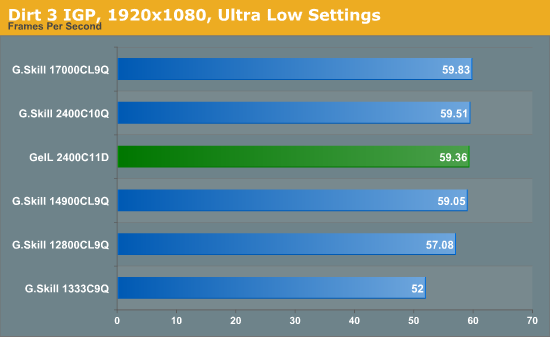GeIL Evo Veloce Review: 2x8GB at DDR3-2400 C11-12-12 1.65 V
by Ian Cutress on October 24, 2012 5:50 PM EST- Posted in
- Memory
- Ivy Bridge
- DDR3
- GeIL
Metro2033
Metro2033 is a DX11 benchmark that challenges every system that tries to run it at any high-end settings. Developed by 4A Games and released in March 2010, we use the inbuilt DirectX 11 Frontline benchmark to test the hardware at 1920x1080 with full graphical settings. Results are given as the average frame rate from 4 runs.

Against DDR3-1333, our GeIL kit today offers a 7.67% increase in frame rates in our Metro2033 test on IGP. This falls in between the 6.86% increase from the 1866 C9 and 8.87% increase from the 2133 C9 kits. Arguably we could conclude that Metro likes lower CL numbers, as the MemTweakIt suggests that our kit should achieve similar to the 2133 C9 kit.
Civilization V
Civilization V is a strategy video game that utilizes a significant number of the latest GPU features and software advances. Using the in-game benchmark, we run Civilization V at 1920x1080 with full graphical settings, similar to Ryan in his GPU testing functionality. Results reported by the benchmark are the total number of frames in sixty seconds, which we normalize to frames per second.

Similar results are seen with Civ V like Metro2033, but this time we get only a 5.29% increase over DDR3-1333. The kit again performs more like a 1866 C9 than the 2133 C9.
Dirt 3
Dirt 3 is a rallying video game and the third in the Dirt series of the Colin McRae Rally series, developed and published by Codemasters. Using the in game benchmark, Dirt 3 is run at 1920x1080 with Ultra Low graphical settings. Results are reported as the average frame rate across four runs.

Even though in the past we have shown Dirt 3 to love CPU MHz and GPU capacity, when it comes to memory the results seem to top off around the 1866 C9 mark. All the kits between 1866 C9 and 2400 C10 give an 8-10% performance boost on IGP over 1333 C9.










30 Comments
View All Comments
Tchamber - Wednesday, October 24, 2012 - link
It would be nice to see how memory impacts gaming with a graphics card. Or does the difference get so small that there's no meaningful difference?Magnus101 - Wednesday, October 24, 2012 - link
I think it already is no meaningful difference in most games, even with the integrated GPU!As with all memory performance tests, the real world difference is so small that it makes no sense to throw money at higher speced memory.
Almost in all circuimstances, perhaps except some special cases like they highlighted in an earlier article hear at anand.
The biggest difference there was for Winrar64 compression (not the usual unpacking we normal user do almost daily) and that was still only 20% differece between 1333 and 2400.
I haven't seen any benchies with memory for compilers (programing) or for DAW (music making, like with cubse, sonar and so on), but I suspect it is the same old story of almost no difference.
tekphnx - Thursday, October 25, 2012 - link
Second Life at max settings is a notable exception. I recently upgraded from DDR3-1600 to DDR3-2000 on my i5-760 @3.8ghz with GTX670, and saw a jump of 5-6fps in minimum framerates.JonnyDough - Friday, October 26, 2012 - link
I COMPLETELY agree. This article is BOGUS. Here's why:If you're going to spend money on higher end memory then you may as well fork over a little for a discreet graphics card instead. It will make much more difference in games.
Intel integrated graphics are only good for office usage still. No real gamer or anyone doing heavy GPU calculations, cares about Intel IGPs.
Show us what this more costly memory does for a real gamer and we'll consider purchasing it. Three frames per second more on an IGP is not worth the money spent on this memory.
IanCutress - Friday, October 26, 2012 - link
That's the thing - not everyone that has a PC uses it for gaming. As alluded to by Magnus, there are other things that do not need a discrete GPU but are still used by a large number of enthusiasts - VMs, compilations, even non-parallel scientific simulations. You whack in a stupidly large matrix into memory and it will bog down. Failing that, how about financial calculations? Now put all that inside a mITX chassis and board where you're limited to two memory slots. Sure 2x8GB 2400 C11 may not be your first port of call, but if saving an extra 3-5% time on whatever you do actually has a financial impact on your work portfolio, then the early investment could pay off in the long run. Then again, it may not and that 2x4GB 1333 C9 is looking a little sweeter.No article is bogus, as you put it. Sure there are good things to review and some that are not so good. If we solely focused on the good, then we'd all be sitting around patting each other on the back for doing a service to the industry. I like reviewing all sorts - you get to see the niggles of the smaller companies that can't invest, or you can point out when a top company is just being stupid. Thus when you get a really good product that shines out from the rest, it is something special to behold.
Ian
PS There are plans for a compilation benchmark in future reviews. I'm trying to organise a decent one that I can strap a timer to without sitting in front of the screen for 20 minutes waiting for it to finish.
Runamok81 - Friday, October 26, 2012 - link
True, not everyone uses a PC for gaming. But do you really think the "frost white" Evo Veloce memory is targeted towards the financial or enterprise sector? As silly as it is, Enthusiasts with money than sense WILL pay a premium to raise their benchmark synthetics.ytoledano - Wednesday, October 24, 2012 - link
Sticks like these coupled with a X79 motherboard with 8 DIMMs populated are biting into server territory - I'm sure! I'm running a 3930K + 48GB (I will soon have to upgrade to 64) as a dedicated SQL server. How much would similar performance cost me if I'd built the system around a Xeon? Probably twice.Blibbax - Wednesday, October 24, 2012 - link
Roughly £400 extra for the Xeon equivalent of the 3930K.quixver - Tuesday, November 20, 2012 - link
You are missing out on ECC though.Beenthere - Wednesday, October 24, 2012 - link
Anyone who has actually tested higher RAM frequencies or RAM quantities above 4 GB. in a typical modern desktop PC knows that frequencies above 1600 MHz. produce no tangible system performance gain in either Intel or AMD powered PCs. Tangible means a change in system performance that you can actually see and or feel. In addition more than 4 GB. of RAM produces minimal gains unless you operate your PC with many applications open or functioning concurrently, which most people don't. CAD, modeling, and some other business applications CAN benefit from more RAM but many consumer apps don't.Be advised that RAM benches grosssly mis-represent the actual SYSTEM gains because they assume the RAM is saturated 100% of the time, which it is not. If you run real applications and compare 1333 MHz. to 2400 MHz. you will likely not even be able to tell the difference between the two because DDR3 RAM @ 1333+ MHZ. is not a system bottleneck.
The RAM mfgs. are doing everything they can to convince enthusiasts to buy high priced high frequency RAM because this is very profitable for them. When you test with real applications and see how tiny the system gains are, you will wish that you had bought 1600 or 8166 MHz. RAM at a reasonable price and used the cash for a faster CPU or GPU.
If you have money burning a hole in your pocket then by all means buy the fastest RAM you can find. Then you can brag at how cool it is... even if you can't actually use the highest frequency in your PC. Understand that your CPU may not be able to run the RAM anywhere near it's rated frequency. Typically Deneb CPUs top out around 1600 MHz., Thubans around 1800 MHz., Zambezi at 2000+ MHz. and Vishera around 2400 MHz. based on initial testing for Vishera. No one cares about Intel CPUs so I won't post on them... <LOL>